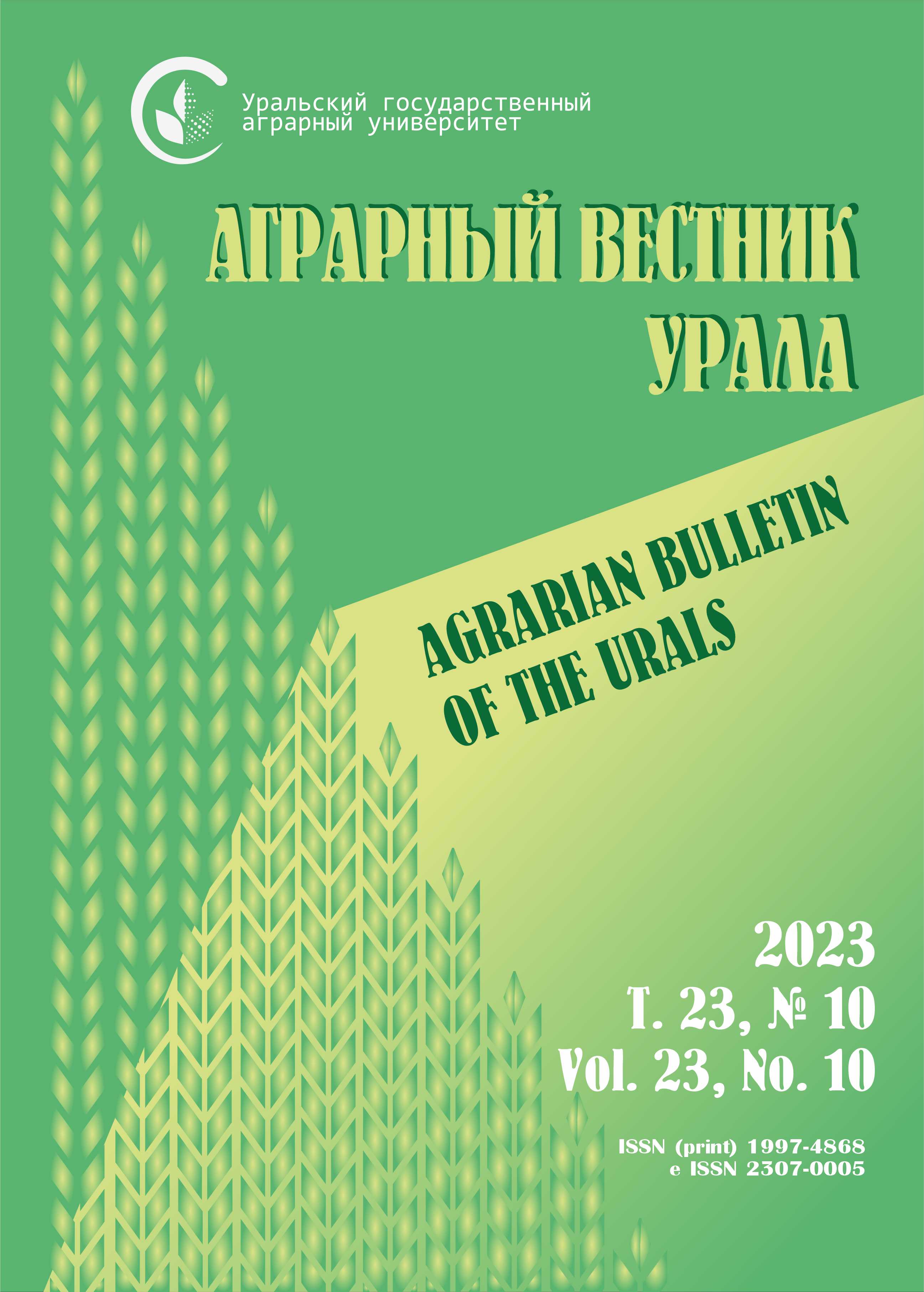Abstract. This article presents the results of a long-term study of collectible varieties of oats in the Tyumen region. The purpose of the study is to study the collection of spring oats, which forms high technological indicators, to increase grain production and to improve its quality. Materials and methods of research. The experiment was conducted in 2019–2021 in the conditions of the Tyumen Region at the experimental field of the Northern Trans-Urals Research Institute (Russia), using generally accepted methods of analysis and standard techniques. 167 varieties of oats of various ecological and geographical origins were evaluated according to the main technological indicators (grain type, weight of 1000 seeds and filminess), the Otrada variety was used as a standard. Results. A positive relationship of grain yield with the mass of 1000 seeds was established for all years of study (r = 0.21…0.45), a negative relationship was observed for all years with the film content of grain (r = –0.21; –0.31; –0.36). Regression analysis determined a significant positive effect on increasing the yield of 1000 seeds, negative – film content. Varieties of oats with a consistently high natural grain weight were identified: k-15272 (USA), 15254 (USA), k-15234 (Lithuania), k-15340 (Omsk region), weight of 1000 seeds: k-15278, (Moscow region), 15013 (Altai Krai), k-15330 (Ulyanovsk region), k-14402 (USA). As well as a low percentage of films: k-15301 (Canada), k-15272 (USA), k-15280 (Moscow region), k-15048 (Finland). The distinguished varieties of oats are particularly valuable for a number of reasons, they can be used in breeding work as sources, and they have high potential and product quality: k-15013 (Altai Krai), k-13911 (Leningrad region), k-15330 (Ulyanovsk region), k-15425 (Germany), k-15272 (USA), k-15301 (Canada). Scientific novelty. A comprehensive assessment of 167 varieties of spring oats was carried out and the most promising ones were identified, differing in the best technological quality indicators, which can be recommended in breeding work in order to improve the quality of grain, not inferior in yield.
breeding, grain quality, sources, grain nature, mass 1000, filminess
1. Batalova G. A. Selekciya ovsa na kachestvo zerna v Volgo-Vyatskom regione // Zernobobovye i krupyanye kul'tury. 2018. № 3 (27). S. 81-87. DOI: 1024411/2309-348X-2018-11038. DOI: https://doi.org/10.24411/2309-348X-2018-11038; EDN: https://elibrary.ru/UZFJSG
2. Krotova N. V., Batalova G. A. Izuchenie kollekcionnyh obrazcov golozernogo ovsa // Trudy po prikladnoy botanike, genetike i selekcii. 2021. T. 182. № 4. S. 18-26. DOI:https://doi.org/10.30901/2227-8834-2021-4-18-26. EDN: https://elibrary.ru/GTWWQP
3. Shvachko N. A., Loskutov I. G., Semilet T. V. et al. Bioactive Components in Oat and Barley Grain as a Promising Breeding Trend for Functional Food Production // Molecules. 2021. Vol. 26. No. 8. Article number 2260. DOI:https://doi.org/10.3390/molecules26082260. EDN: https://elibrary.ru/WUMSMY
4. Polonskiy V., Loskutov I., Sumina A. Biological role and health benefit of antioxidant compounds in cereals // Biological Communications. 2020. Vol. 65. No. 1. Pp. 53-67. DOI: https://doi.org/10.21638/spbu03.2020.105; EDN: https://elibrary.ru/UCFLXQ
5. Paudel D., Dhungana B., Caffe M. et al. A Review of Health-Beneficial Properties of Oats // Foods. 2021 Vol. 10. No. 11. Article number 2591. DOI:https://doi.org/10.3390/foods10112591. EDN: https://elibrary.ru/FNAITG
6. Poonia A., Phogat D. S., Versha et al. Biochemical assessment of oat genotypes revealed variability in grain quality with nutrition and crop improvement implications // Food Chemistry. 2022. Vol. 377. URL: https://www.sciencedirect.com/science/article/abs/pii/S0308814621029885 (date of reference: 07.04.2023).
7. Loskutov I. G., Butris V., Kosareva I. A., Blinova E. V., Novikova L. Yu. Alyumotolerantnost' i mikroelementnyy sostav zernovki sortov ovsa iz kollekcii VIR s razlichnoy stepen'yu selekcionnoy prorabotki // Trudy po prikladnoy botanike, genetike i selekcii. 2022. T. 183. № 3. S. 96-110. DOI:https://doi.org/10.30901/2227-8834-2022-3-96-110. EDN: https://elibrary.ru/WCLSXA
8. Lyubimova A. V., Eremin D. I., Mamaeva V. S. [i dr.] Katalog biohimicheskih pasportov sortov ovsa posevnogo sibirskoy selekcii // Vestnik KrasGAU. 2022. № 5 (182). S. 73-83. DOI:https://doi.org/10.36718/1819-4036- 2022-5-73-83. DOI: https://doi.org/10.36718/1819-4036-2022-5-73-83; EDN: https://elibrary.ru/RTYWDM
9. Vasina E. A., Butovec E. S., Luk'yanchuk L. M. Rezul'taty izucheniya ishodnogo materiala soi v usloviyah Primorskogo kraya dlya selekcionnyh celey // Trudy po prikladnoy botanike, genetike i selekcii. 2022. T. 183. № 4. C. 19-29. DOI:https://doi.org/10.30901/2227-8834-2022-4-19-29. EDN: https://elibrary.ru/SZUJVA
10. Fomina M. N., Ivanova Yu. S., Pay O. A., Bragin N. A. ‘Tobolyak' - sort ovsa yarovogo universal'nogo ispol'zovaniya // Trudy po prikladnoy botanike, genetike i selekcii. 2021. T. 182. № 2. S. 107-113. DOI:https://doi.org/10.30901/2227- 8834-2021-2-107-113. DOI: https://doi.org/10.30901/2227-8834-2021-2-107-113; EDN: https://elibrary.ru/XLOLIA
11. Ivanova Yu., Fomina M., Yaroslavtsev A. Ecological plasticity and stability of collection samples of naked oats in the conditions of the Northern TRANS-Urals // Bioscience research. 2020. Vol. 17. No. 2. Pp. 1183-1185. EDN: https://elibrary.ru/JZIUHJ
12. Eremin D. I., Lyubimova A. V., Tautekenova A. K., Kochneva D. A. Elementy produktivnosti i harakter ih nasledovaniya gibridami F1 ovsa yarovogo (Avena sativa L.) v Zapadnoy Sibiri // Dostizheniya nauki i tehniki APK. 2022. T. 36. № 7. S. 25-30. DOI:https://doi.org/10.53859/02352451_2022_36_7_25. EDN: https://elibrary.ru/OUICWW
13. Eremin D. I. Moiseeva M. N. Sortovaya otzyvchivost' ovsa na mineral'nye udobreniya v usloviyah Severnogo Zaural'ya // Izvestiya Orenburgskogo gosudarstvennogo agrarnogo universiteta. 2021. № 2 (88). S. 45-48. EDN: https://elibrary.ru/KWJRPA
14. Zobnina I. V. Perspektivnye obrazcy ovsa yarovogo (Avena sativa), adaptirovannye k prirodno-klimaticheskim usloviyam Severnogo regiona RF // Agrarnyy vestnik Urala. 2019. № 3 (182). S. 4-11. DOI: https://doi.org/10.32417/article_5ce3ce28b79b25.36191158; EDN: https://elibrary.ru/RWVKOE
15. Ivanova Yu. S., Fomina M. N., Loskutov I. G. Biohimicheskie pokazateli kachestva zerna u kollekcionnyh obrazcov ovsa golozernogo v usloviyah severnoy lesostepi // Dostizheniya nauki i tehniki APK. 2018. T. 32. № 6. S. 38-41. DOI:https://doi.org/10.24411/0235-2451-2018-10609. EDN: https://elibrary.ru/XYUJYL
16. Sorokin O. D. Prikladnaya statistika na komp'yutere. Novosibirsk: GUP RPO SO RAHN, 2004. 162 s.









